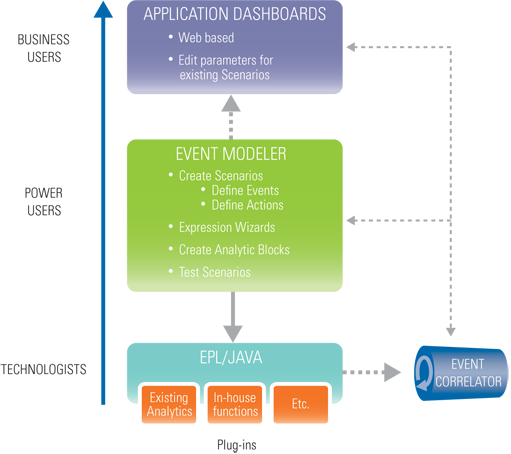Understanding the different user viewpoints
Apama has been designed for a range of users. The figure below shows the spectrum of users from technologists, business technology users, referred to as power users, up to pure business users. Apama provides different facilities for each of these classes of user. After the initial design is set for an Apama application, multiple users can work concurrently to implement the design.
Technologists can make use of the full set of APIs and technologies within the Apama architecture to create sophisticated, custom, CEP solutions. Using Apama Studio they can create applications directly in EPL or Java. They can extend the capabilities of the Apama correlator with their own in-house analytic routines. Using the Integration Adapter Framework (IAF) they can integrate with a new data service by developing a new adapter if one that can be plugged in does not already exist. They can also take advantage of low-level APIs for building custom client user interfaces in C, C++, Java and .Net.
Power users are provided with GUI tools (Event Modeler and Dashboard Builder) to enable the creation of scenarios without having to write code. A scenario is a sequence of event monitoring and event responses that constitutes a single business activity. A scenario can be an application in its own right, or part of a bigger application. Using the Event Modeler graphical tool, you can create scenarios from reusable blocks.
Thus, there are three approaches to developing Apama applications. Your development team can use one, two, or all three in an Apama application:

EPL — Apama’s native event processing language

Java — Apama provides a Java in-process API for processing events

Event Modeler — Apama’s GUI for creating event processing scenarios
Pure business users are often only interested in the end-game application. The output of the Dashboard Builder tool provides an immediately usable application for this purpose.
In addition, Apama provides management and monitoring tools for users whose primary responsibility is to manage deployed Apama applications.
Copyright © 2013
Software AG, Darmstadt, Germany and/or Software AG USA Inc., Reston, VA, USA, and/or Terracotta Inc., San Francisco, CA, USA, and/or Software AG (Canada) Inc., Cambridge, Ontario, Canada, and/or, Software AG (UK) Ltd., Derby, United Kingdom, and/or Software A.G. (Israel) Ltd., Or-Yehuda, Israel and/or their licensors.

